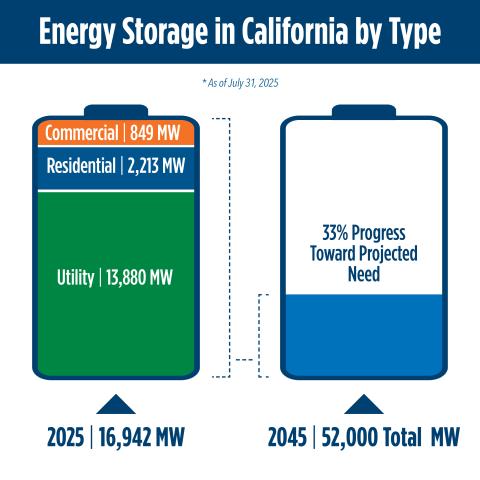California Energy Storage System Survey
Energy storage is an important tool to support grid reliability and complement the state’s abundant renewable energy resources. These technologies capture energy generated during non-peak times to be dispatched at the end of the day and into the evening as the sun sets and solar resources go offline, reducing dependence on fossil fuel generation to meet peak loads.
The Public Utilities Code defines an energy storage system as a commercially available technology that absorbs energy, storing it for a specified period, and then dispatches the energy. From 2018 through mid- 2025, battery storage capacity in California increased from 500 megawatts (MW) to more than 16,900 MW. The state projects 52,000 MW of battery storage will be needed by 2045.
This dashboard presents statewide data for residential, commercial, and utility-scale installations as of July 31, 2025.
Dashboard is best viewed from a computer. Visit Tableau for the full page layout of dashboard or download data.
CAISO BESS: A Battery Energy Storage System (BESS) managed by the California Independent System Operator (CAISO). It stores and releases electricity to help balance supply and demand, stabilize the grid, and support renewable energy use in California.
CAISO Hybrid: A hybrid energy system managed by the CAISO that combines different types of energy resources, like batteries and renewable generation sources, to improve grid reliability and efficiency.
CAISO-OOS BESS: A CAISO BESS system located outside of the state of California.
CAISO-OOS Hybrid: A CAISO Hybrid system located outside of the state of California.
Energy Storage - a commercially available technology that is capable of absorbing energy, storing it for a period of time, and thereafter dispatching the energy.
Kilowatt - a measure of 1,000 watts of electrical power.
Megawatt - a unit of power equal to one million watts, especially as a measure of the output of a power station.
Other: A combination of energy storage resources from different public utilities that are not managed by the CAISO.
Planned CAISO: Energy storage resources that are identified in the CAISO interconnection queue that are scheduled to be added to the grid in the future but are not yet active.
Data in this dashboard is obtained through a survey of all utilities in California and is current as of July 31, 2025. The dataset will be updated semi-annually upon completion of each survey.
The use of the terms megawatts and kilowatts as descriptive of battery energy storage is to effectively convey the instantaneous power contribution of battery storage as comparable to the power produced by grid-level generators. We recognize that energy capacity in the context of energy storage typically refers to the total energy a battery can hold in watt-hours, kilowatt-hours, megawatt-hours, etc. However, for statewide planning and reliability purposes, understanding the peak power capability of battery energy storage systems allows for the integration of data with the nameplate capacity of traditional power generation units serving the grid. It is in this context that battery systems are able to be effectively compared for their ability to serve the grid over short periods of time, typically two to four hours per day depending upon system conditions.
Storage systems have capacities reported as low as five kilowatts, and some totals are reported to the nearest megawatt. This might cause some small rounding errors.
Utility data on installations of energy storage systems may not be available for all zip codes. Due to variations in local permitting regulations, not all utilities reported energy storage systems as separately identifiable from a co-located solar photovoltaic system.
California legislation under AB 2514 (Skinner, Chapter 469, Statutes of 2010) encourages utilities to incorporate energy storage into the electricity grid. Energy storage can provide a multitude of benefits to California, including supporting the integration of greater amounts of renewable energy into the electric grid, deferring the need for new fossil-fueled power plants and transmission and distribution infrastructure, and reducing dependence on fossil fuel generation to meet peak loads.
California legislation under SB 846 (Dodd, Chapter 239, Statutes of 2022) requires the CEC to expand the energy almanac report to include storage resources that serve wholesale load. SB 846 also requires the CEC to report on energy resources that serve load in the Independent Systems Operator system. This dashboard meets both of these requirements.
For more information:
- Achieving 100% Clean Electricity in California (March 2021)
- California's Clean Energy Transition Plan (May 2023) - PDF
Citing
Please cite use of these data and images. California Energy Commission [Year]. California Energy Commission California Energy Storage System Survey. Data last updated [insert date last updated]. Retrieved [insert date retrieved] from https://tableau.cnra.ca.gov/t/CNRA_CEC_PUBLIC/views/EnergyStorageDashbo…
Contact
Michael Nyberg, Energy Assessments Division, Data Integration Branch | qfergen@energy.ca.gov | 916-931-9477

